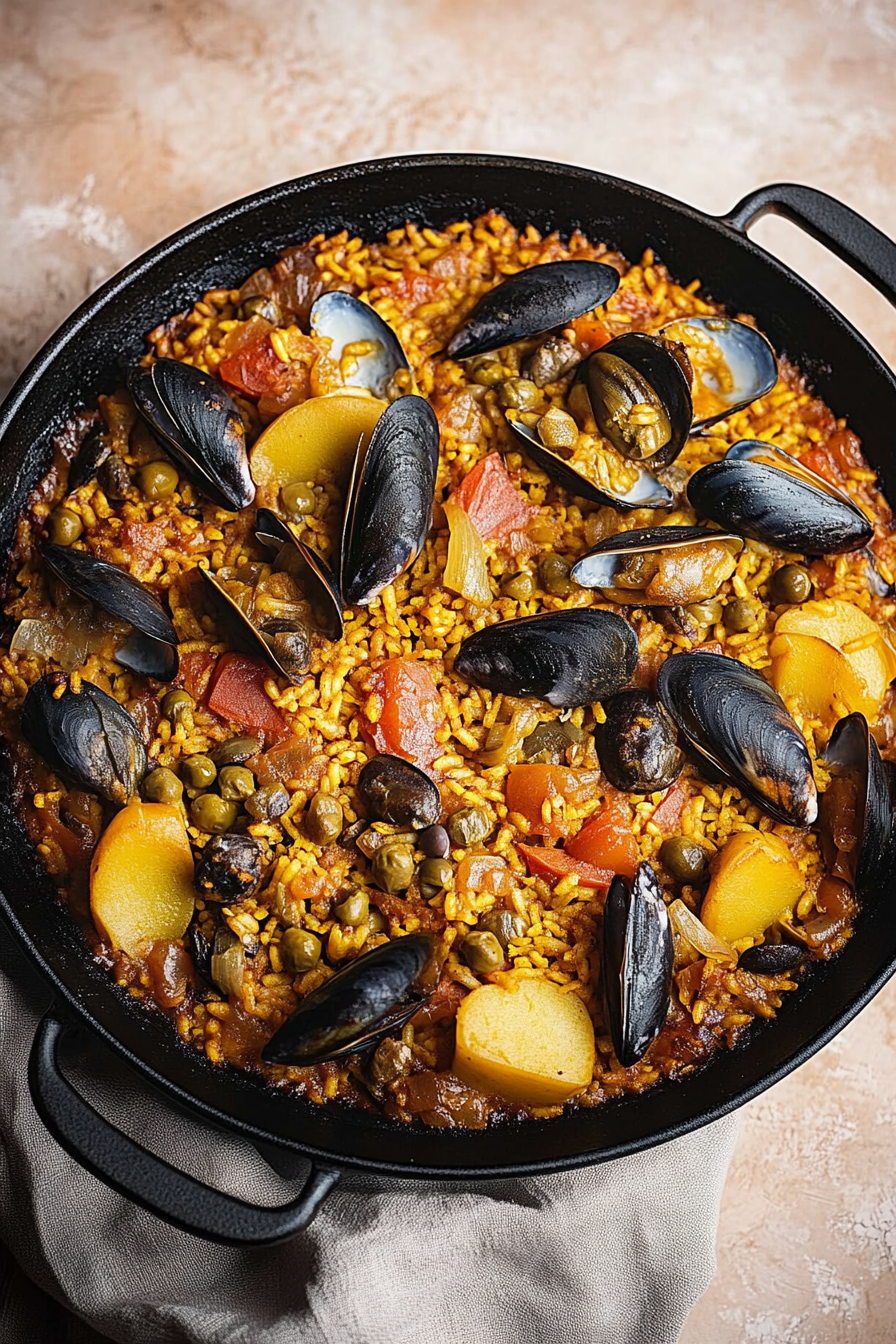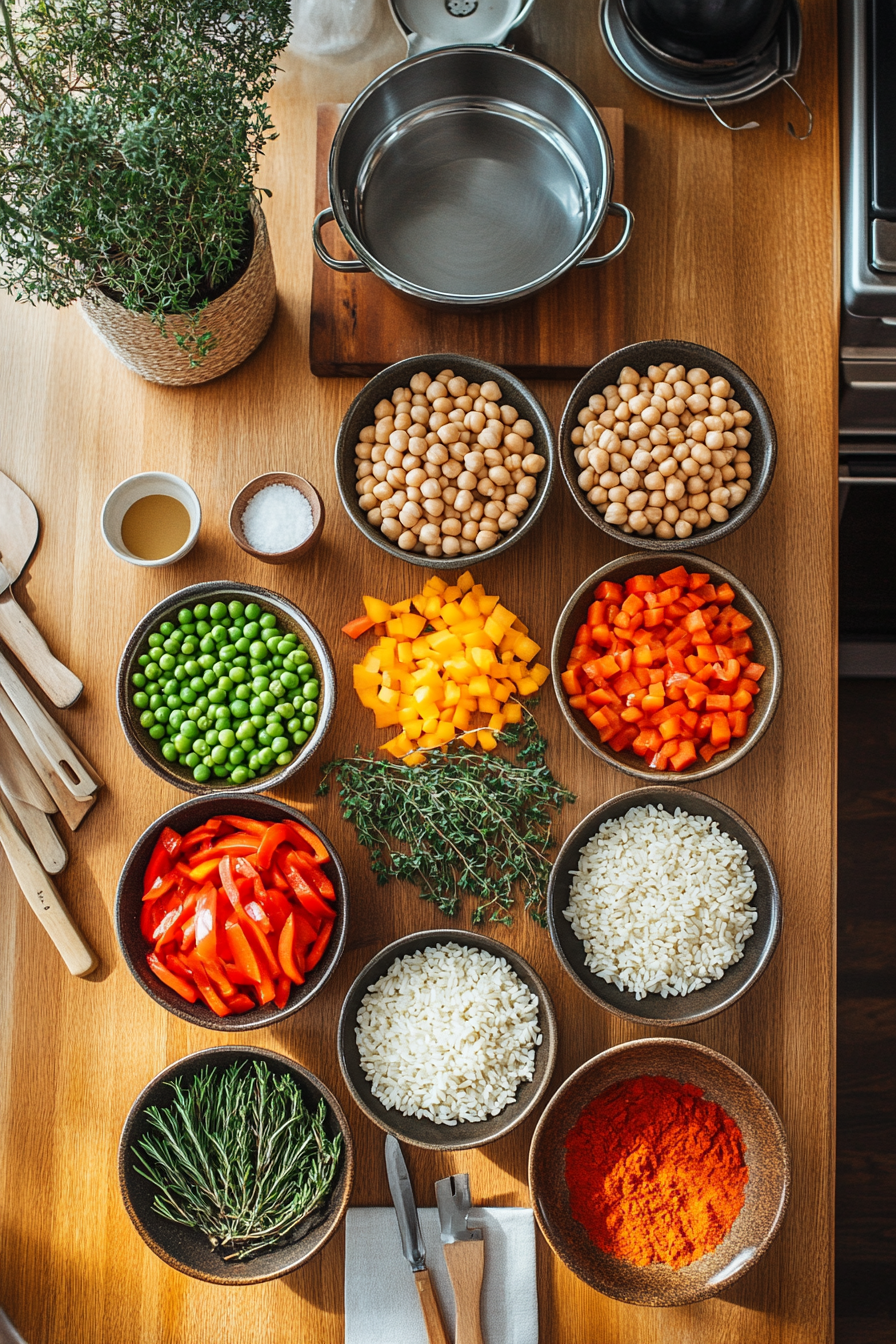Mastering vegetarian paella
Vegetarian paella is a vibrant, nourishing dish that brings the iconic flavors of Spanish cuisine to your table without meat or seafood. This recipe uses wholesome plant-based ingredients such as fresh vegetables, fragrant saffron, and short-grain paella rice to craft a meal that is both gluten-free and vegan-friendly. It’s a fantastic choice for those seeking a healthy, hearty, and satisfying dish that captures the spirit of traditional paella’s rich taste and colorful presentation.
The process incorporates a delicate balance of smoky paprika, fresh herbs, and the warmly aromatic saffron threads (or turmeric as an affordable substitute), simmered together to infuse the rice with unforgettable flavor. With options to personalize through mushrooms, chickpeas, or olives, vegetarian paella offers versatility for seasonal produce and seasonal tastes. Perfect for weekend gatherings or a wholesome weeknight dinner, this dish brings together nutrition, flavor, and simplicity in a single pan.
Benefits and Advantages of vegetarian paella
Simple and Approachable Cooking
This vegetarian paella recipe is easy to prepare, making it accessible for cooks of all experience levels. It requires straightforward ingredients and techniques, such as sautéing vegetables, simmering rice without stirring, and letting the dish rest, which helps build layers of flavor with minimal active cooking time.
Health Benefits
Packaged with fresh vegetables, fiber-rich peas, and optionally protein-loaded chickpeas, this dish is a nutrient-dense option. The use of olive oil adds healthy monounsaturated fats, while saffron and smoked paprika provide antioxidants and anti-inflammatory properties. Being naturally gluten-free and vegan expands its inclusivity, catering to diverse dietary needs.
Flavorful and Colorful Experience
The use of saffron imparts the signature golden hue and subtle earthy aroma essential to authentic paella. Combined with the smoky depth of paprika, vibrant vegetables, and the crispy socarrat crust on the bottom, this dish delivers a full sensory delight that is both visually stunning and delicious.
Versatile and Customizable
Vegetarian paella is highly customizable—seasonal vegetables, legumes, and garnishes allow for plenty of variation. It can be made as a lighter main or a more robust meal by adjusting portion sizes and additional ingredients.
Essential Ingredients for vegetarian paella
- 3 tablespoons olive oil, divided
- 4 cups low sodium vegetable broth
- 1 teaspoon saffron threads (or 1 teaspoon ground turmeric as a substitute)
- 1 medium onion, diced
- 1 red bell pepper, thinly sliced
- 5 cloves garlic, minced
- 1 large tomato, diced (or ½ cup canned diced tomatoes)
- 1½ cups paella rice (such as Bomba, Calasparra, or Arborio)
- 1 teaspoon smoked paprika
- ½ teaspoon sweet paprika
- 1 teaspoon sea salt, plus more to taste
- Fresh cracked pepper, to taste
- 2 sprigs fresh thyme (or 1 teaspoon dried thyme)
- ¾ cup frozen peas, thawed
- Optional ingredients: 8 ounces mushrooms, sliced; 1 can (15-ounce) chickpeas, rinsed and drained; lemon wedges; fresh parsley; ⅓ cup sliced green olives
Dietary Substitutions to Customize Your vegetarian paella
Customizing vegetarian paella to fit your dietary preferences or ingredient availability can be simple and rewarding. Here are some substitution ideas:
- Rice: While short-grain rice varieties like Bomba or Calasparra are ideal for texture and absorption, Arborio rice works well as a substitute. For gluten-free needs, all rice types are naturally gluten-free.
- Broth: Use low-sodium broth to control saltiness, or homemade vegetable broth for richer flavor. If you prefer, water with additional seasoning can also suffice.
- Saffron: Saffron provides distinct flavor and color, but for a cost-effective alternative, ground turmeric imparts a golden hue and mild earthiness without overpowering the dish.
- Vegetables: Customize based on seasonality or preference—zucchini, artichokes, green beans, or asparagus can replace or complement bell peppers and peas.
- Protein: While chickpeas provide plant-based protein and texture, you can also add cannellini beans or omit legumes entirely for lower carbohydrate content.
- Oil: Extra virgin olive oil is recommended for flavor and health benefits, but any light vegetable oil works in a pinch.
- Herbs: Fresh thyme is preferred, but dried thyme or rosemary can add different aromatic layers. Fresh parsley, added at serving, enhances freshness.
With these substitutions, you can create a vegetarian paella perfectly tailored to your taste and dietary requirements without compromising on traditional flavors.
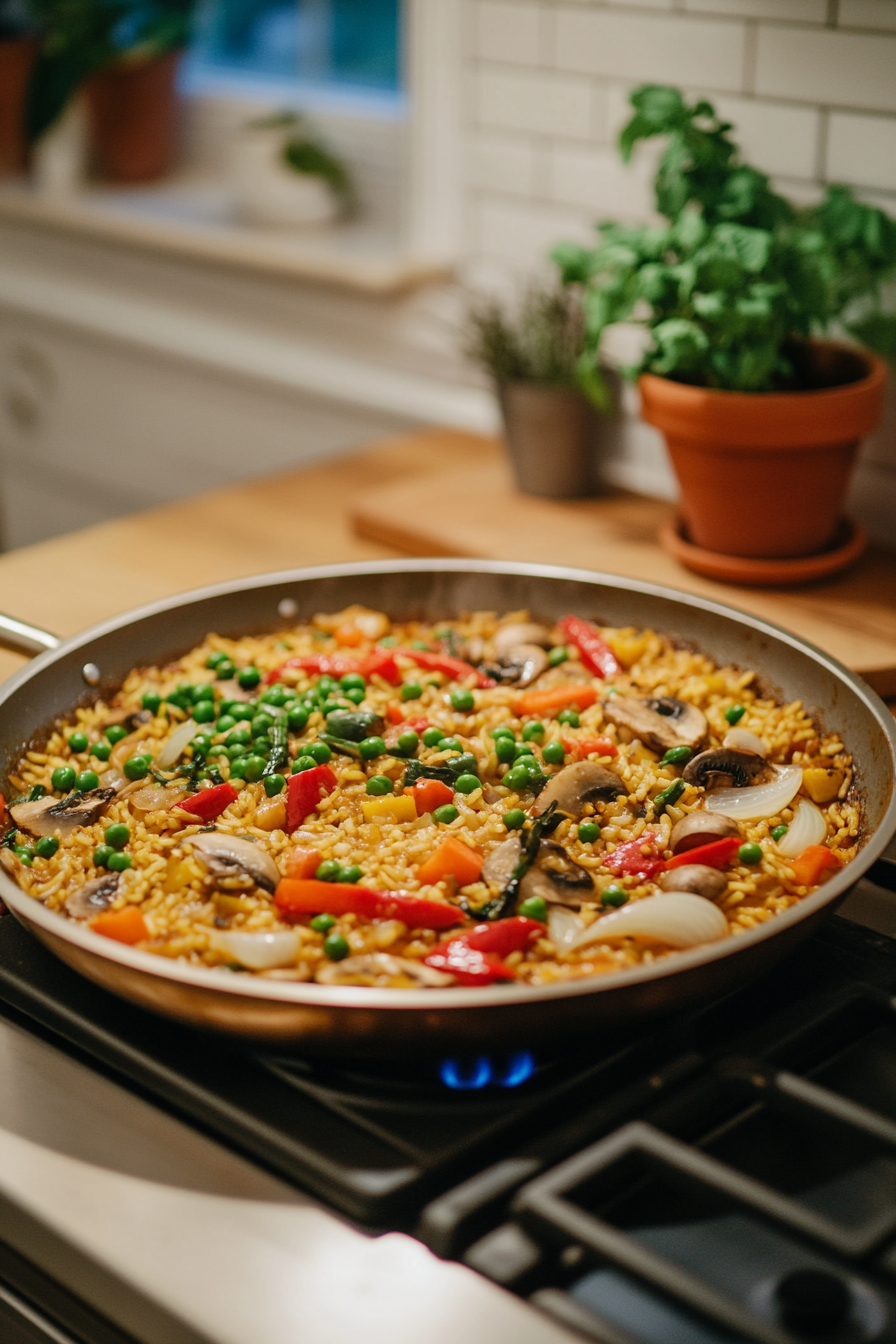
How to Prepare the Perfect vegetarian paella: Step-by-Step Guide
Creating a delicious vegetarian paella involves layering flavors and textures carefully while respecting traditional cooking methods. Follow these steps for an authentic and tasty dish:
- Warm the broth: Combine 4 cups low sodium vegetable broth with 1 teaspoon saffron threads (or ground turmeric) in a medium saucepan. Bring to a simmer and keep warm over low heat.
- Sauté the vegetables: Heat 2 tablespoons olive oil in a paella pan or large skillet over medium heat. Add 1 diced medium onion, 1 thinly sliced red bell pepper, and 8 ounces sliced mushrooms (optional). Cook until softened, about 3 to 5 minutes.
- Add aromatics: Stir in 5 cloves minced garlic and cook for about 1 minute. Add 1 large diced tomato or ½ cup canned diced tomatoes, 1 teaspoon smoked paprika, ½ teaspoon sweet paprika, and 2 sprigs fresh thyme (or 1 teaspoon dried thyme). Cook for another 1-2 minutes for fragrant flavor.
- Incorporate the rice: Add 1½ cups paella rice (such as Bomba, Calasparra, or Arborio) and remaining 1 tablespoon olive oil. Stir to coat and lightly toast the rice for 1 minute.
- Add broth and seasoning: Slowly pour in the warm broth mixture. Season with 1 teaspoon sea salt and fresh cracked pepper to taste. From this point, avoid stirring the rice to maintain texture.
- Simmer gently: Bring the mixture to a heavy simmer over medium-high heat for 1-2 minutes, then reduce heat to medium-low. Simmer for 15-20 minutes until the rice is al dente. Rotate the pan occasionally for even cooking.
- Create socarrat: Listen for a crackling sound indicating the rice is forming a golden, crispy crust on the bottom; do not stir it. This cherished part adds extra flavor and texture.
- Finish with toppings: When most broth is absorbed, scatter ¾ cup thawed frozen peas, 1 can (15-ounce) rinsed chickpeas, and optional garnishes like fresh parsley, sliced green olives, and drizzle parsley oil.
- Rest and serve: Cover the pan with foil and let it rest for 5-8 minutes to allow flavors to meld and rice to absorb residual liquid. Serve with lemon wedges for a fresh, citrusy finish.
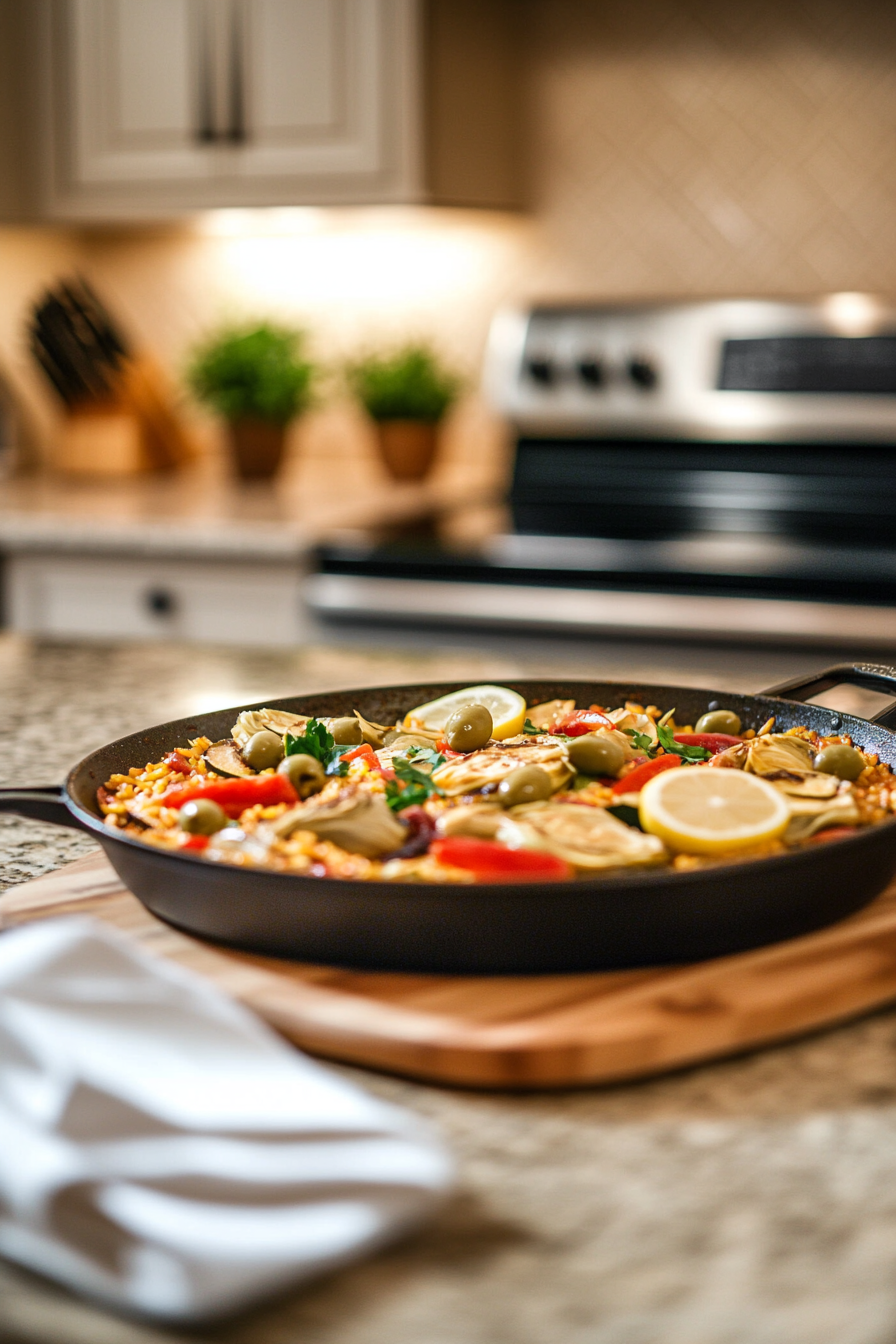
Mastering vegetarian paella: Advanced Tips and Variations
To perfect your vegetarian paella and make it your own, consider these tips and variations.
Advanced Tips
- Use authentic rice: Short-grain rice varieties like Bomba or Calasparra are ideal for absorbing flavors without becoming mushy.
- Broth temperature: Always add warm broth to avoid interrupting the cooking process and to promote even cooking.
- Do not stir after adding broth: Stirring releases starch and makes paella creamy, which is not authentic. Avoid it to develop the proper texture and socarrat.
- Use a wide, shallow pan: This allows even heat distribution and optimal liquid evaporation, key to a great paella.
Variations
- Seasonal vegetables: Swap or add vegetables such as artichokes, green beans, or asparagus based on availability.
- Additional protein: Incorporate vegan protein sources like seitan, tempeh, or extra chickpeas for heartiness.
- Spices and herbs: Mix in smoked paprika and crushed red pepper flakes for heat, or fresh rosemary for aromatic touches.
- Different garnishes: Use roasted red peppers, toasted almonds, or a drizzle of good quality extra virgin olive oil for added flavor.
How to Store vegetarian paella: Best Practices
Storing your vegetarian paella correctly preserves flavor and texture for leftovers or make-ahead meals.
Refrigeration
- Cool the paella to room temperature before transferring it to an airtight container.
- Store in the refrigerator for up to 3-4 days.
Freezing
- Freeze portions in airtight containers or freezer bags for up to 2 months.
- Thaw overnight in the refrigerator before reheating.
Reheating
- Gently reheat covered in a skillet or oven at low heat, adding a splash of vegetable broth to prevent drying out.
- A microwave can be used for convenience but may soften the rice texture.
Nutritional Value of vegetarian paella
| Nutrient | Amount per Serving | Details |
|---|---|---|
| Calories | 366-563 kcal | Varies due to optional ingredients |
| Carbohydrates | 59-122 g | Major energy source from rice and vegetables |
| Protein | 9-16 g | Plant-based protein from chickpeas and peas |
| Fat | 10-12 g | Healthy fats mainly from olive oil |
| Sodium | 528-690 mg | Moderate; adjust broth and seasoning as needed |
| Fiber | 4-9 g | Supports digestion from plant ingredients |
| Sugar | 4-10 g | Natural sugars mainly from vegetables |
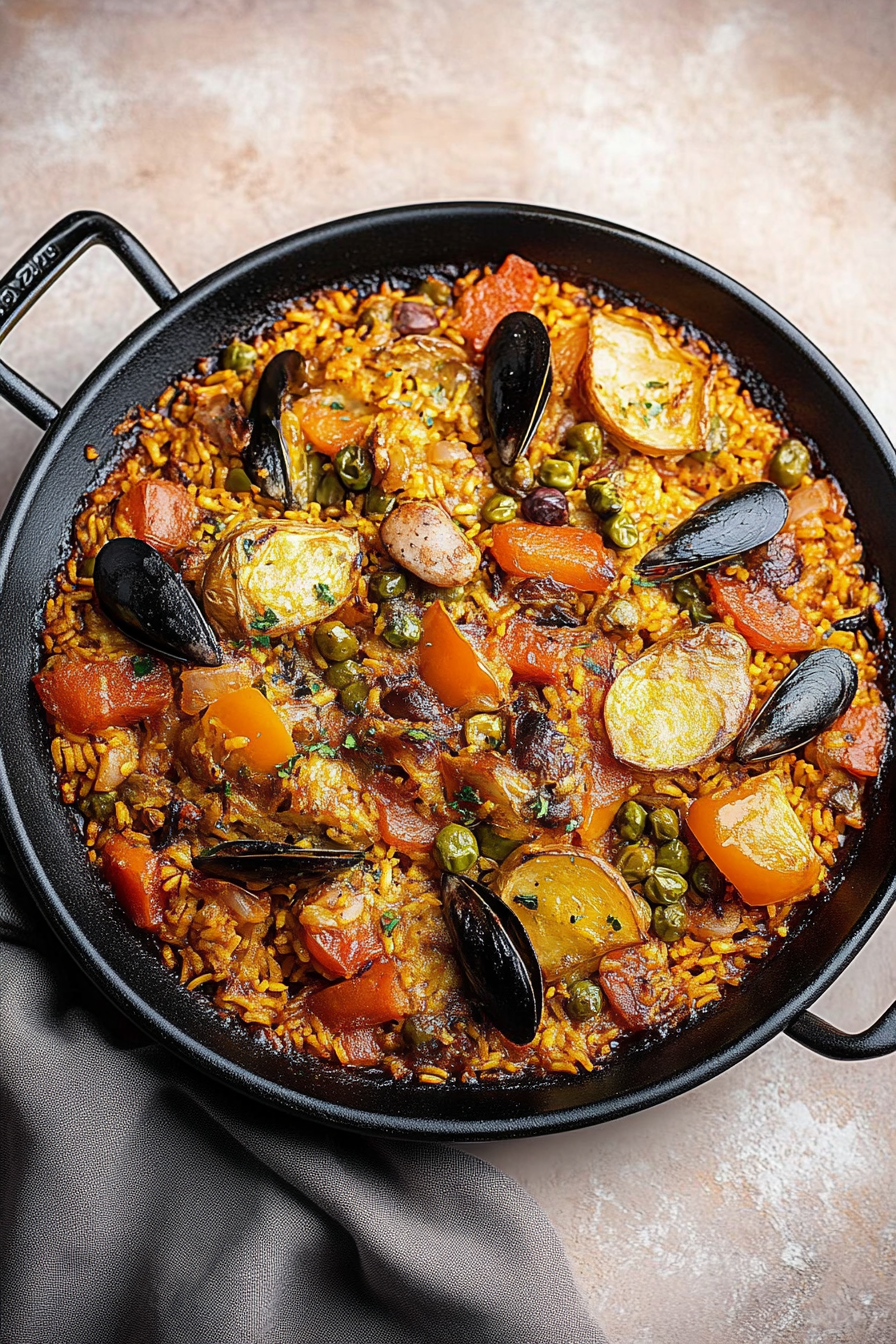
FAQs: Frequently Asked Questions About vegetarian paella
What type of rice is best for vegetarian paella?
Short-grain rice varieties like Bomba and Spanish Calasparra are preferred as they absorb liquid well without getting mushy. Arborio can be used as a substitute. Avoid stirring the rice after adding the broth to prevent a creamy texture.
How can I achieve the golden color in vegetarian paella?
Saffron gives authentic color and flavor to paella. Turmeric is a less expensive alternative that also contributes a vibrant yellow color.
Do I need a special pan to make vegetarian paella?
A wide, shallow paella pan is ideal for even cooking and forming socarrat, the crispy rice crust. If unavailable, a large flat-bottomed stainless steel pan is a good alternative. Avoid using non-stick pans as they prevent socarrat formation.
How do I create socarrat in my vegetarian paella?
To form socarrat, allow the broth to absorb without stirring and listen for a crackling sound. The bottom layer turns golden and crispy with practice. Avoid burning it; less socarrat is better than burnt rice.

Delicious Vegan and Gluten-Free Spanish Paella: A Tasty Vegetarian Delight
- Total Time: 1 hour
- Yield: 4 servings 1x
- Diet: Vegan
Description
🥘 Indulge in a vibrant and flavorful Spanish paella, perfectly crafted for a satisfying vegan and gluten-free meal.
🌱 Enjoy a harmonious blend of spices and vegetables that come together to offer a delightful culinary experience.
Ingredients
3 tablespoons olive oil, divided
4 cups low sodium vegetable broth
1 teaspoon saffron threads (or ground turmeric as a substitute)
1 medium onion, diced
1 red bell pepper, thinly sliced
5 cloves garlic, minced
1 large tomato, diced (or 1/2 cup canned)
1 1/2 cups paella rice (e.g., Bomba, Calasparra, or Arborio)
1 teaspoon smoked paprika
1/2 teaspoon sweet paprika
1 teaspoon sea salt, plus more to taste
Fresh cracked pepper, to taste
2 sprigs fresh thyme (or 1 teaspoon dried thyme)
3/4 cup frozen peas, thawed
Optional: 8 ounces mushrooms, sliced; 1 can (15-ounce) chickpeas, rinsed and drained; lemon wedges; fresh parsley; 1/3 cup sliced green olives
Instructions
In a medium saucepan, combine vegetable broth and saffron threads, and bring to a simmer; keep warm over low heat.
Heat 2 tablespoons olive oil in a paella pan or large skillet over medium heat.
Sauté onion, bell pepper, and mushrooms (if using) until softened, about 3-5 minutes.
Add garlic, sauté for another minute, then stir in tomatoes, smoked paprika, sweet paprika, and thyme, cooking for 1-2 minutes.
Add rice and remaining tablespoon olive oil, stirring to coat and toast rice for 1 minute.
Slowly add the broth mixture, season with salt and pepper, and avoid stirring from this point.
Bring to a heavy simmer over medium-high heat for 1-2 minutes, then reduce heat to medium-low and simmer for 15-20 minutes until rice is al dente, rotating pan occasionally.
As the broth is absorbed, listen for a crackling sound and check for socarrat formation—the desired golden, crispy crust on the bottom.
Once the broth is nearly absorbed, scatter peas, chickpeas, and garnish options like parsley oil over the top without stirring, cover with foil, and let rest for 5-8 minutes.
Serve with lemon wedges and optional garnishes.
Notes
🍚 Use short-grain rice for best texture; adjust liquid if rice absorbs too quickly.
💛 Saffron is ideal for authentic flavor, but turmeric can substitute.
⏲️ Allow paella to rest after cooking to finish absorption and meld flavors.
- Prep Time: 15 minutes
- Resting Time: 5-8 minutes
- Cook Time: 35 minutes
- Category: Main Course
- Method: Simmering
- Cuisine: Spanish
Nutrition
- Serving Size: 1 serving
- Calories: 466
- Sugar: 7 g
- Sodium: 609 mg
- Fat: 11 g
- Saturated Fat: 1.5 g
- Unsaturated Fat: 9.5 g
- Trans Fat: 0 g
- Carbohydrates: 90 g
- Fiber: 7 g
- Protein: 13 g
- Cholesterol: 0 mg

